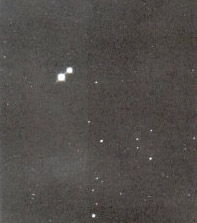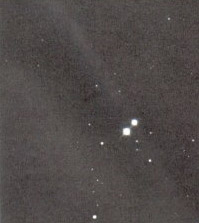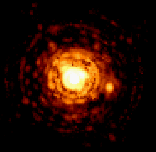61 Cygni
 1916 |  1951 |
61 Cygni was christened the "Flying Star" in 1792 by Giuseppe Piazzi (1746-1826) for its unusually large proper motion. Its apparent position would shift by an amount equal to the width of the full moon in only 150 years.
This visual binary system is located about 11.4 light-years (ly) away from our Sun, Sol, in the south central part (21:08:52.1+38:56:51:D~, ICRS 2000.0) of Constellation Cygnus, the Swan -- southeast of Sadr (Gamma Cygni) and east of the open star clusters M 29 and NGC 6871, and the Crescent Nebula (NGC 6888). It is the title member of the 61 Cygni group.(Solstation)
In 1830, Friedrich Georg Wilhelm von Struve (1793-1864) made the first measurements of the star as a binary system. It is now known that 61 Cygni A and B orbit each other at an "average" distance (semi-major axis) of 86.4 times the Earth-Sun distance, or about 86 astronomical units (AUs) -- which is more than twice Pluto's orbital distance in the Solar System. 61 Cygni was the first star system (other than the Sun) to have its distance to Earth successfully calculated by Friedrich Wilhelm Bessel (1784-1846) using trigonometric parallax and the diameter of the Earth's orbit around the Sun in 1838. Smaller and dimmer than the Sun, the stars are barely visible with the naked eye.(Solstation)
61 Cygni-A is an orange-red main-sequence dwarf star of spectral type K3.5-5.0Ve. It has about 70 percent of a solar mass, 72 percent of its diameter and about 8.5 percent of its luminosity. It appears to have about 79 percent of the Sun's metallicity. It appears to be a variable star. It orbits 61 Cygni-B with a highly elliptical orbit (e=0.40) that gives distance extremes 51.7 and 121.0 AUs in an orbit of period about 722 years. 61 Cygni B is and orange-red main sequence dwarf of spectral type K4.7-7.0 Ve. It has about 63 percent of of a solar mass, 67 percent of its diameter, and 3.9 percent of its luminosity.
Sources:
Nearby Stars
Star Concepts
| HyperPhysics***** Astrophysics | R Nave |
